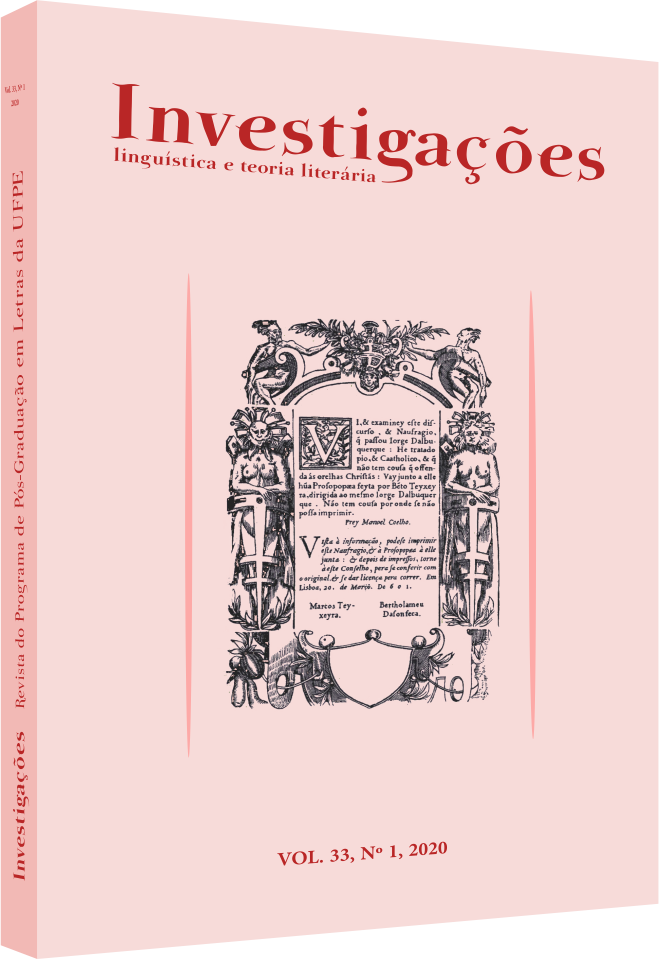Entre o estranhamento e a carnavalização: considerações sobre as relações de espaço-sujeito em Os transparentes, de Ondjaki
DOI:
https://doi.org/10.51359/2175-294x.2020.245322Keywords:
traditions, innovations, space, individuals.Abstract
The novel Os transparentes, by Ondjaki, presents a city built by ordinary people in its thirst for survival and a particular mythical world. This work aims to analyse elements that set up this scenario and theirs traditions and innovations. Then, I will use a theoretical repertoire that reflects the category of space and its relations with individuals, such as Chklóvski's theory of strangeness and de-automaticization, and Bakhtin's ideas of carnivalization. I understand that the novel returns to diverse literary and cultural traditions, but the text also inserts itself with invention language in the contemporary literary scene.References
ARENAS, Fernando. África Lusófona: além da independência. Trad. Cristiano Mazzei. São Paulo: Edusp, 2019.
BAKHTIN, Mikhail. A cultura popular na idade média e no renascimento: o contexto de François Rabelais. Trad. Yara Frateschi Vieira. São Paulo: Editora Hucitec, 1987.
BAKHTIN, Mikhail. Estética da criação verbal. Trad. Paulo Bezerra. São Paulo: Martins Fontes, 2006.
CHKLÓVSKI, Viktor. Arte como procedimento. In: OLIVEIRA, Toledo de (Org.) Teoria da Literatura: formalistas russos. Porto Alegre: Globo, 1976.
ONDJAKI. Os transparentes. São Paulo: Companhia das Letras, 2013.
REIS; LOPES, A. C. M. Dicionário de teoria da narrativa. São Paulo: Ática, 1988.
REUTER, Yves. Introdução à análise do romance. Trad. Bergamini; Arruda; Sette; Jouët-Pastré. São Paulo: Martins Fontes, 2004.
TAVARES, Paula. Amargos como os frutos: poesia reunida. Rio de Janeiro: Pallas, 2011.
Downloads
Published
How to Cite
Issue
Section
License
Copyright (c) 2020 Raíra Vasconcelos

This work is licensed under a Creative Commons Attribution 4.0 International License.
Authors who publish with Revista Investigações agree to the following terms:
Authors retain copyright and grant the journal right of first publication with the work simultaneously licensed under the Creative Commons Attribution 4.0 International (CC BY 4.0) license that allows others to share the work with an acknowledgement of the work's authorship and initial publication in this journal.
Authors are able to enter into separate, additional contractual arrangements for the non-exclusive distribution of the journal's published version of the work (e.g., post it to an institutional repository or publish it in a book), with an acknowledgement of its initial publication in this journal.
You are free to:
Share — copy and redistribute the material in any medium or format for any purpose, even commercially.
Adapt — remix, transform, and build upon the material for any purpose, even commercially.
The licensor cannot revoke these freedoms as long as you follow the license terms.
Under the following terms:
Attribution — You must give appropriate credit , provide a link to the license, and indicate if changes were made . You may do so in any reasonable manner, but not in any way that suggests the licensor endorses you or your use.
No additional restrictions — You may not apply legal terms or technological measures that legally restrict others from doing anything the license permits.

